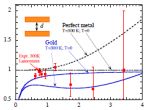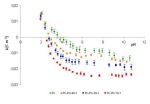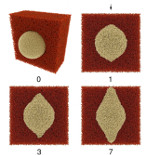News
EPJ H Highlight - Penrose’s and Hawking’s early math award
- Details
- Published on 11 November 2014

Find out how Roger Penrose and Stephen Hawking won recognition for their work on space time singularities back in the sixties, suggesting an initial start to the universe
In 1966, it was Roger Penrose who won the prestigious Adams prize for his essay: An Analysis of the Structure of Space Time. The Adams prize—named after the British mathematician John Couch Adams—is awarded each year by the Faculty of Mathematics at the University of Cambridge to a young, UK-based mathematician. At the same time, Stephen Hawking won an auxiliary to the Adams prize for an essay entitled Singularities and the Geometry of Spacetime, shortly after completing his PhD. A copy of the original submission has now been reproduced in EPJ H.
EPJ B Video - Competent Editorial Staff and Quick Handling System
- Details
- Published on 10 November 2014
Here's why you should publish your article on condensed matter or complex systems in EPJ B.
EPJ B Colloquium - Femto-nano-optics: ultrafast nonlinearity of metal nanoparticles
- Details
- Published on 05 November 2014

A deep understanding of the internal dynamics of metal nanoparticles, through the measurement of their time resolved optical response, requires detailed modeling of the physical processes involved. This EPJ B Colloquium explores the nonlinear ultrafast optical response of metal nanoparticles which can be obtained experimentally in ensembles and single nanoparticles, through femtosecond pump-probe spectroscopy.
EPJ B Highlight - On-demand conductivity for graphene nanoribbons
- Details
- Published on 05 November 2014

Physicists from Uzbekistan and Germany have devised a theoretical model to tune the conductivity of graphene zigzag nanoribbons using ultra-short pulses
Physicists have, for the first time, explored in detail the time evolution of the conductivity, as well as other quantum-level electron transport characteristics, of a graphene device subjected to periodic ultra-short pulses. To date, the majority of graphene studies have considered the dependency of transport properties on the characteristics of the external pulses, such as field strength, period or frequency. The new findings have now been published in EPJ B by Doniyor Babajanov from the Turin Polytechnic University in Tashkent, Uzbekistan, and colleagues. These results may help to develop graphene-based electronic devices that only become conductors when an external ultra-short pulse is applied, and are otherwise insulators.
EPJ D Highlight - Plasma: Casimir and Yukawa mesons
- Details
- Published on 29 October 2014

The Casimir electromagnetic fluctuation forces across plasmas are analogous to so-called weak nuclear interaction forces, as new findings show
A new theoretical work establishes a long-sought-after connection between nuclear particles and electromagnetic theories. Its findings suggests that there is an equivalence between generalised Casimir forces and what are referred to as weak nuclear interactions between protons and neutrons. The Casimir forces are due to the quantisation of electromagnetic fluctuations in vacuum, while the weak nuclear interactions are mediated by subatomic scale particles, originally called mesons by Yukawa. These findings by Barry Ninham from the Australian National University, in Canberra, and European colleagues, have now been published in EPJ D.EPJ A Highlight - Achieving high resolution in binary nuclear reactions with outgoing fast neutrons – at last!
- Details
- Published on 28 October 2014

To date, the two-nucleon pick-up and stripping counterparts of the (p,t) and (t,p) reactions, the (3He,n) and (n, 3He) reactions, have been poorly investigated due to the difficulty in performing high-resolution measurements of fast-neutron energies. The best time-of-flight (3He,n) measurements report resolutions not better than 250 keV. This lack of experimental resolution has hindered a full understanding of the role of proton pairing in nuclei.
EPJ E Highlight - Ion adsorption matter in biology
- Details
- Published on 28 October 2014

New systematic study of the electrical properties of model lipid membranes could improve our understanding of biological cells and opens new possibilities for medical diagnostics
Biological membranes are mainly composed of lipid bilayers. Gaining a better understanding of adsorption of solution ions onto lipid membranes helps clarify functional processes in biological cells. Now, a new study provides a quantitative description of the equilibria between lipid membranes and surrounding solution ions. Joanna Kotyńska and Zbigniew Figaszewski from the University of Bialystok, Poland, are the authors of a study describing these findings, just published in EPJ E. In addition to shedding some light on biological processes, these results could also have implications for, among other things, the future development of medical diagnostics.
EPJ B Video - EPJ B Colloquia, introductions to new research directions
- Details
- Published on 22 October 2014
Luciano Colombo explains the benefits of colloquia papers in EPJ B.
EPJB Colloquium - Embedded nanocrystals get reshaped by ion beams
- Details
- Published on 20 October 2014

A new Colloquium paper published in EPJ B looks at ion irradiation techniques as a means to control the structure of nanoclusters and nanocrystals embedded in solid materials, such as silica or silicon.
EPJ E Highlight - Thermodiffusion in weightlessness
- Details
- Published on 20 October 2014

Zero gravity experiments on the International Space Station shed some light on thermodiffusion effects, relevant to the oil and gas industry and global warming prevention processes
Thermodiffusion, also called the Soret effect, is a mechanism by which an imposed temperature difference establishes a concentration difference within a mixture. Two studies by Belgian scientists from the Free University of Brussels, recently published in EPJ E, provide a better understanding of such effects. They build on recent experimental results from the IVIDIL—Influence Vibration on Diffusion in Liquids—research project performed on the International Space Station under microgravity to avoid motion in the liquids.




